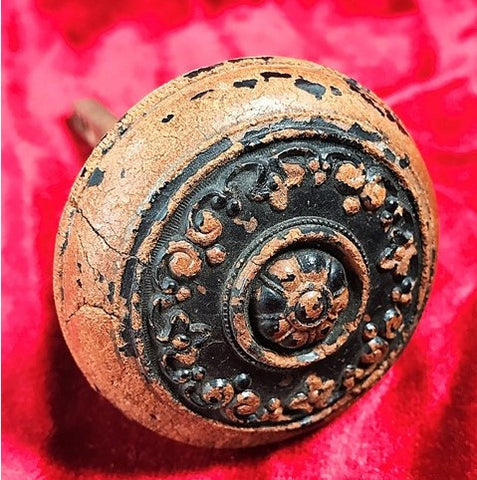We are currently undergoing maintenance - thank you for your patience
We are currently undergoing maintenance - thank you for your patience
April 11, 2017 2 Comments
|
n. |
1. |
A composition made from blood, mixed with mineral or vegetable substances, used for making buttons, door knobs, jewelry etc. |

With the growth of slaughtering and butchering trades in the 19th century, disposing of large quantities of blood became an issue. You literally couldn't give the stuff away! London butchers in Newport Market were banned from tipping blood into the sewers as it would attract rats. Luckily recycling was already a common practice: phosphorous matches were made from ground bones, tobacco ash was re-purposed into tooth-cleaner, and desiccated fish eyes were used for the buds on fake flowers- delightful!
These innovations were a catalyst for creative approaches to blood disposal, as a headline from the January 1892 issue of Manufacturer and Builder magazine suggests:
Door Knobs, etc., from Blood and Sawdust.
Invented by Dr W H Dibble of New Jersey, Hemacite is a material made from sawdust and the blood of slaughtered animals. Primarily from cattle and pig, the blood and sawdust, combined with 40 thousand pounds per square inch of hydraulic pressure and chemical compounds, transformed into surprisingly durable and beautiful everyday items.
This composition was pre-plastic, and ideal for everything from doorknobs to roller skate wheels to products such as buttons, cash register keys and even jewelry. The composition of Hemacite was touted as susceptible to a high polish, impervious to heat, moisture, atmospheric changes, and practically indestructible.
An article “to skate manufacturers and dealers” in the New York Times, on 11 October 1885, stated that “the superiority of our Hemacite Roller over boxwood is now well known.” The success of the campaign spawned other articles like a 21 February 1903 Times ad by the Siegel Cooper department store, promoting 75-cent roller skates with Hemacite wheels, a more expensive option than skates with “plain black wheels.” Strangely enough, these adds were often juxtaposed with plugs for products like Plasmon Cocoa Mix- “A blood-invigorating and muscle-making beverage of the highest order.” Plasmon’s active ingredient was Albumen, the organic binding agent behind Hemacite roller skate wheels. Clever marketing or a dark sense of humor?!
At the time of the Manufacturer and Builder article, Dibble Manufacturing Company had been producing Hemacite architectural details and door knobs for quite some time. Rather than having a separate knob and shaft to wear out, Dibble’s knobs were molded as one unbreakable piece, and came with a guarantee for the lifetime of the door.

Due to its consistency, Hemacite is easy to confuse with Bakelite. Even cheaper to produce, the popularity of plastics like Bakelite almost entirely replaced the production of Hemacite by the early to mid-1900’s. Ever strong and durable, these house fixtures and doorknobs live on today- you can spot several in our nationally registered museum case at Hippo Hardware, and on occasion we will get a few in for sale. Talk about a real “conversation piece” to adorn your home!

October 09, 2017
I found this very interesting….a piece of history that I never knew about.
Comments will be approved before showing up.
March 22, 2024

September 08, 2023 1 Comment

January 29, 2023


Bill Z. Bubb
February 22, 2019
Fascinating!
As a key, padlock collector (door knobs are but a turn-away.) The information, background, newsy advise to remind me to stop pouring slaughter animal blood down the sewer drains is much appreciated. (I’ve been wondering why ‘rats wearing goggles’ have been poking their faces up the commode piping! The question has been answered! For which, I am grateful.
Thanks for writing the tutorial, I will be passing along a hyperlink to the key + lock boards I attend to, your time invested into ‘education’ for others is well spent and MUCH appreciated!
BillPS I recognize it is unlikely my note of thanks will not likely be published, that’s okay.